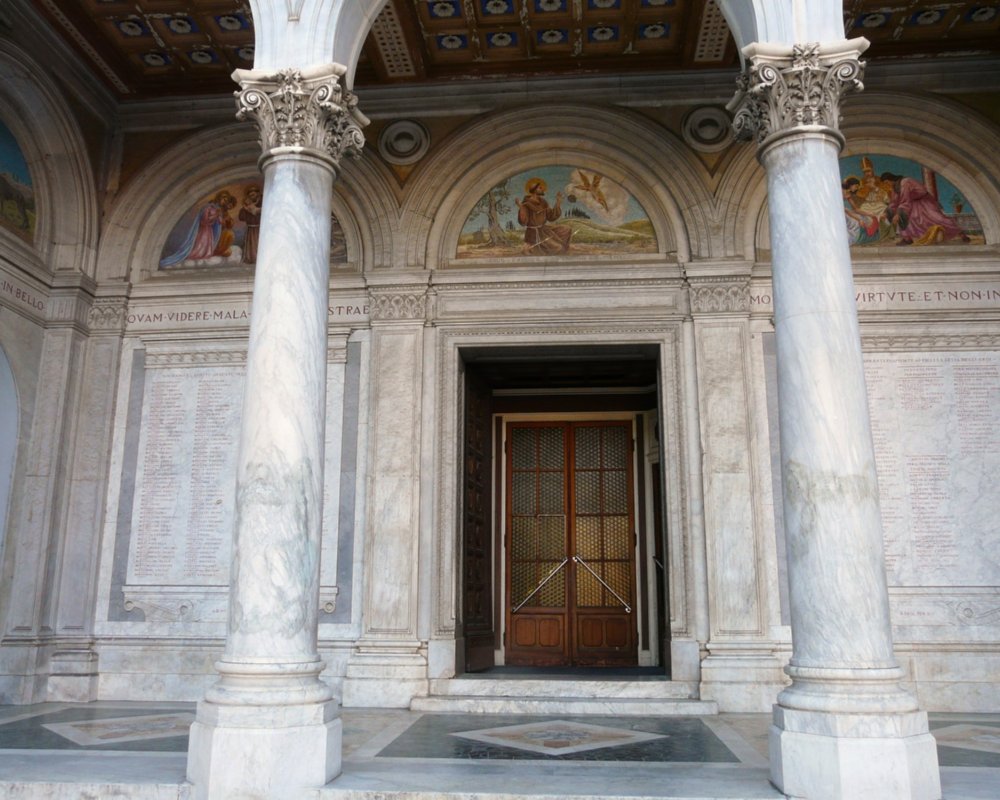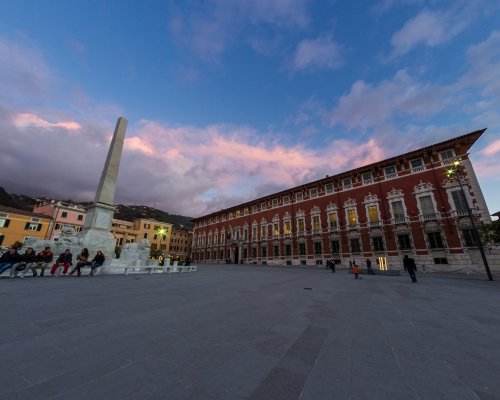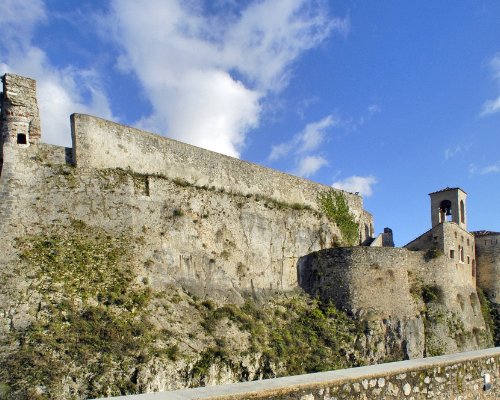Three days of culture in the kingdom of white gold
In northern Tuscany, the Apuan Riviera is a stretch of coast where white marble mountains melt into a turquoise sea in the blink of an eye. Originally the area was part of the territory of Emilia-Romagna and only became part of Tuscany in the census of 1881.
Here is a 3-day itinerary for an immersion in this often-overlooked corner of Tuscany, far from the tourist roads, and with two cultural mines not to be missed: Massa and Carrara.
5km from the Tyrrhenian sea lies Massa, from where this three-day culture cruise starts. After a coffee in piazza Aranci, the square lined with candy coloured buildings and fruit trees, walk to the 13th century Cathedral of Saints Peter and Francis, home to works by Pinturicchio and Benedetto Buglioni. For art enthusiasts this can be nicely complimented with a visit to the Diocesan Museum, a Ducal palace from the 15th century, home of two striking altarpieces by Renaissance painter Bernardino del Castelletto, originally from Lombardy but active at length in Massa, a polychrome wood sculpture of a monk saint by Iacopo della Quercia and a bronze crucifix attributed to Gian Lorenzo Bernini.
The day continues with a stroll that leads to the Guadagnucci Museum, housed in the 18-century Villa della Rinchiostra, framed by a splendid park; inside is a unique collection of marble works by sculptor Gigi Guadagnucci.
For a foodie break there are numerous traditional trattorias for some typical Massesi dishes, such as marinated salt cod or torta d'erbi, a typical spinach and ricotta pie from the area.
For those who prefer a spa break, Cinquale di Montignoso is the perfect place to take advantage of the presence of a wellness center and an exceptional establishment: the Terme della Versilia.
There are also many historic buildings that stand out in the area, including the famous Aghinolfi Castle, with its unique octagonal shape and the beautiful view of the sea and the mountains.
5km from the Tyrrhenian sea lies Massa, from where this three-day culture cruise starts. After a coffee in piazza Aranci, the square lined with candy coloured buildings and fruit trees, walk to the 13th century Cathedral of Saints Peter and Francis, home to works by Pinturicchio and Benedetto Buglioni. For art enthusiasts this can be nicely complimented with a visit to the Diocesan Museum, a Ducal palace from the 15th century, home of two striking altarpieces by Renaissance painter Bernardino del Castelletto, originally from Lombardy but active at length in Massa, a polychrome wood sculpture of a monk saint by Iacopo della Quercia and a bronze crucifix attributed to Gian Lorenzo Bernini.
The day continues with a stroll that leads to the Guadagnucci Museum, housed in the 18-century Villa della Rinchiostra, framed by a splendid park; inside is a unique collection of marble works by sculptor Gigi Guadagnucci.
For a foodie break there are numerous traditional trattorias for some typical Massesi dishes, such as marinated salt cod or torta d'erbi, a typical spinach and ricotta pie from the area.
For those who prefer a spa break, Cinquale di Montignoso is the perfect place to take advantage of the presence of a wellness center and an exceptional establishment: the Terme della Versilia.
There are also many historic buildings that stand out in the area, including the famous Aghinolfi Castle, with its unique octagonal shape and the beautiful view of the sea and the mountains.
The second day starts with a short walk up to the rocky hills of the Apuan alps to visit Malaspina Castle, a 12th century castle that has undergone various transformations throughout the years (it was a prison from the end of the 19th century to 1946) and that boasts some beautiful internal and external frescoes plus a wonderful view of the surrounding countryside.
The itinerary continues with the arrival in Carrara, the world capital of marble, where Michelangelo himself sourced his materials. At the entrance of this marble Disneyland is the statue of Venus by Aldo Buttini: a monument depicting the Roman goddess of love, abandoned in an artist's studio for thirty years before being found and displayed in the city.
Three museums - MUDAC, CARMI and the Civic Marble Museum - allow to have a complete overview of the importance of this precious material. The MudaC - Museums of Arts in Carrara is dedicated to contemporary art. The CARMI - Carrara and Michelangelo Museum is dedicated to the figure of Michelangelo, with a permanent exhibition dedicated to the relationship between the artist and the area. The Civic Marble Museum tells the history of the material from Roman times until the present day.
The second day starts with a short walk up to the rocky hills of the Apuan alps to visit Malaspina Castle, a 12th century castle that has undergone various transformations throughout the years (it was a prison from the end of the 19th century to 1946) and that boasts some beautiful internal and external frescoes plus a wonderful view of the surrounding countryside.
The itinerary continues with the arrival in Carrara, the world capital of marble, where Michelangelo himself sourced his materials. At the entrance of this marble Disneyland is the statue of Venus by Aldo Buttini: a monument depicting the Roman goddess of love, abandoned in an artist's studio for thirty years before being found and displayed in the city.
Three museums - MUDAC, CARMI and the Civic Marble Museum - allow to have a complete overview of the importance of this precious material. The MudaC - Museums of Arts in Carrara is dedicated to contemporary art. The CARMI - Carrara and Michelangelo Museum is dedicated to the figure of Michelangelo, with a permanent exhibition dedicated to the relationship between the artist and the area. The Civic Marble Museum tells the history of the material from Roman times until the present day.
For a leisurely last morning in Carrara, visit the Giorgio Conti Foundation at Palazzo Cucchiari: a one-of-a-kind collection that having previously hosted works by Canova and Giuliano Vangi, continues to put on a number of painting and sculpture exhibitions a year. Wondering through the palace’s frescoed rooms past the swirling staircases the passion Giorgio Conti had for his beloved city of Carrara is palpable.
Although more recognisable in the form of Michelangelo’s David, Carrara’s marble is better seen up close in its natural habitat. To understand where this white gold comes from it’s worth driving the short distance to Colonnata, a precariously ancien village nestled in the shadows of imposing cliff faces. A marble sculpture by the artist Alberto Sparapani symbolizes the sacrifice and dedication of the quarrymen.
This is also the homeland of the unmissable lardo di Colonnata IGP, a traditional salami made with pork lard cured in Carrara marble vats, best eaten cut into thin slices and laid over a piece of toasted bread.
For a leisurely last morning in Carrara, visit the Giorgio Conti Foundation at Palazzo Cucchiari: a one-of-a-kind collection that having previously hosted works by Canova and Giuliano Vangi, continues to put on a number of painting and sculpture exhibitions a year. Wondering through the palace’s frescoed rooms past the swirling staircases the passion Giorgio Conti had for his beloved city of Carrara is palpable.
Although more recognisable in the form of Michelangelo’s David, Carrara’s marble is better seen up close in its natural habitat. To understand where this white gold comes from it’s worth driving the short distance to Colonnata, a precariously ancien village nestled in the shadows of imposing cliff faces. A marble sculpture by the artist Alberto Sparapani symbolizes the sacrifice and dedication of the quarrymen.
This is also the homeland of the unmissable lardo di Colonnata IGP, a traditional salami made with pork lard cured in Carrara marble vats, best eaten cut into thin slices and laid over a piece of toasted bread.


